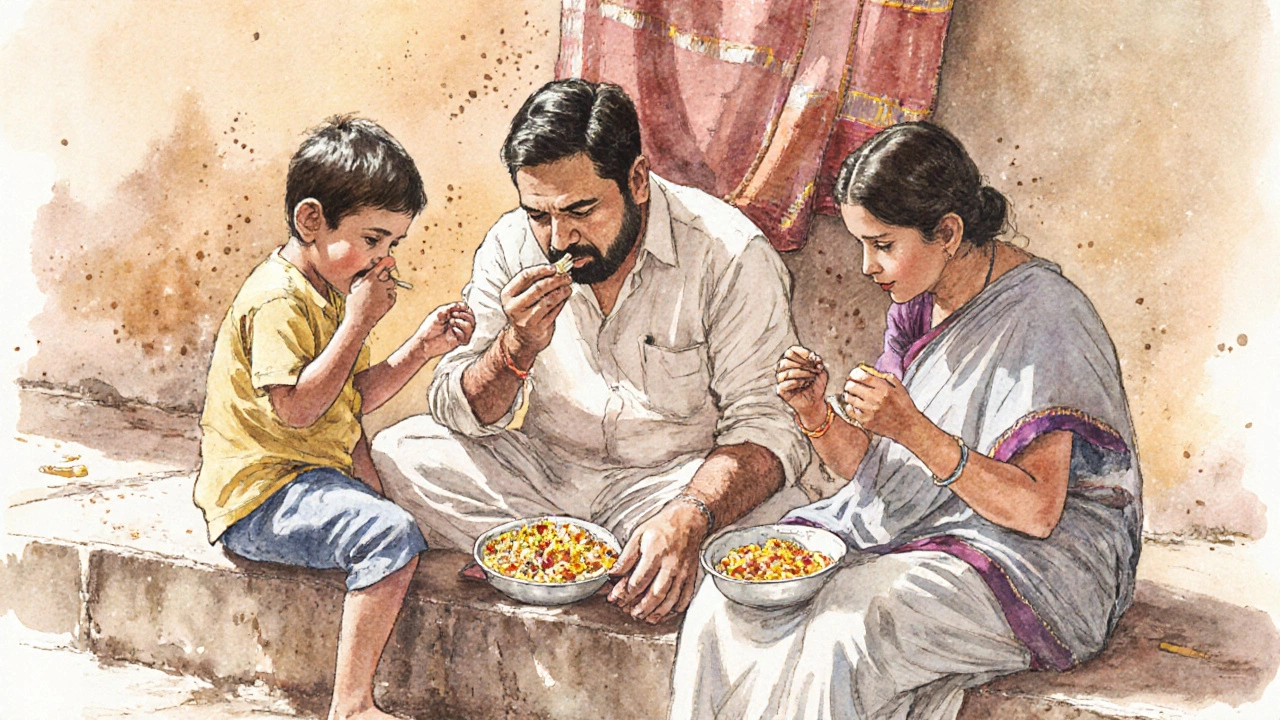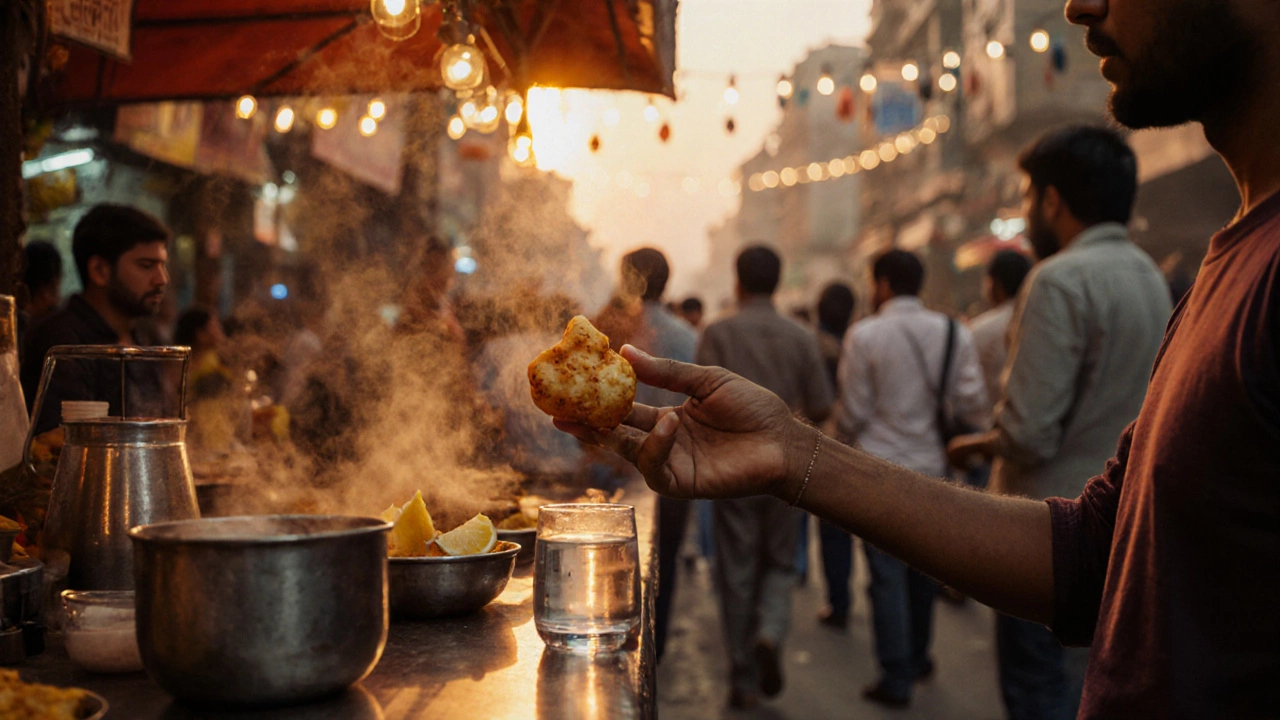5 Nov 2025
- 0 Comments
When you’re standing in a busy street market in Delhi or Mumbai, biting into a crispy pani puri or tearing into a warm bhel puri, you’ll notice something: almost no one uses their left hand to eat. Even if they’re holding a drink or a napkin in their left hand, the food always goes to the right. It’s not about being picky-it’s about deep-rooted cultural practice. And if you’ve ever wondered why, the answer isn’t about dirt. It’s about history, religion, and everyday life.
The Real Reason Behind the Rule
In India, the left hand has traditionally been used for personal hygiene after using the toilet. Before modern plumbing became common, people used water and the left hand to clean themselves. This practice still exists in many rural areas and even in urban homes where bidets or water buckets are standard. Because of this, the left hand became associated with cleaning, not eating. Using it to handle food was seen as unhygienic-not because the hand was literally dirty all the time, but because it was the designated tool for something considered unclean.This isn’t just superstition. It’s a practical system that developed over centuries. In a country where millions eat with their hands, having a clear rule about which hand does what keeps meals clean and respectful. Even today, in homes without indoor plumbing, the left hand is still used for washing after using the toilet. That habit carries over into daily routines, including meals.
How This Plays Out at Street Food Stalls
At a street food vendor in Jaipur or Kolkata, you’ll see vendors handing you food with their right hand. They’ll also hand you napkins or a small plastic bag with your right hand. If you try to take food with your left hand, they won’t scold you-but they might pause, slightly confused. You might even see them adjust the food slightly so it’s easier for you to pick it up with your right.It’s not about judging you. It’s about keeping things smooth. Street food sellers operate on speed and tradition. They’ve seen thousands of customers. They know what works. When you use your right hand, you’re following the rhythm of the place. You’re not breaking a law-you’re showing awareness.
And here’s something most tourists don’t realize: many street food stalls don’t even offer forks or spoons. The whole experience is designed for hand-eating. That’s why you’ll often see a small bowl of water and a lemon wedge nearby. You wash your hands before eating, and you use your right hand to eat. Afterward, you wash again. It’s a ritual, not a chore.
Religion and Rituals: More Than Just Hygiene
The rule also ties into Hindu traditions. In many Hindu households, the right hand is considered pure, linked to spiritual practices like offering food to deities, touching sacred objects, or receiving blessings. The left hand is associated with impurity, not because it’s inherently bad, but because it’s used for tasks considered physically unclean. This isn’t about shame-it’s about separation of functions, like keeping cooking utensils away from trash bins.Even in temples, you’ll see people use their right hand to offer flowers or prasad (blessed food). Priests serve food with their right hand. When you receive prasad, you take it with your right hand. This isn’t a rule for outsiders-it’s part of how the culture organizes respect and cleanliness.
It’s not unique to India. In many Muslim-majority countries, the right hand is used for eating and the left for hygiene. In parts of Southeast Asia and North Africa, similar customs exist. The idea is universal: separate what cleans from what nourishes.

What Happens If You Use Your Left Hand?
If you accidentally pick up a samosa with your left hand, nothing dramatic will happen. No one will yell. No one will refuse to serve you. Most locals will just smile and quietly adjust. Some might even hand you another napkin without saying a word. But if you’re eating with your left hand and then reach for someone else’s plate or touch a shared bowl, you might get a quiet look-because you’ve crossed a boundary.It’s not about being rude on purpose. It’s about unintentionally disrupting a system that keeps meals clean and social. Think of it like wearing shoes inside someone’s home in Japan. You’re not being malicious-you just didn’t know the rule. Once you know, it’s easy to adapt.
Practical Tips for Eating Street Food in India
- Always use your right hand to pick up food. Even if you’re left-handed, switch for meals.
- Wash your hands before eating. Most vendors will have a small bowl of water and lemon nearby. Use it.
- Don’t touch your face or hair after using your left hand before eating.
- If you’re unsure, watch what locals do. They’ll show you the rhythm.
- Don’t feel bad if you slip up. Most people understand tourists are learning.
Many Indian families teach their kids from age two or three: “Right hand for eating, left hand for cleaning.” It’s as natural as brushing your teeth. You don’t think about it-you just do it.
Why This Matters Beyond the Plate
Understanding why the left hand isn’t used for eating isn’t just about avoiding awkward moments. It’s about respecting how culture shapes daily life. In India, food isn’t just fuel. It’s connection. It’s ritual. It’s shared experience. When you eat with your hands, you’re engaging with the texture, temperature, and aroma in a way forks can’t match. But that connection only works when everyone follows the same unspoken rules.Street food is where India’s soul lives. The sizzle of oil, the smell of cumin, the laughter of vendors shouting orders-it’s alive. And part of that life is the quiet, consistent rhythm of using your right hand. It’s not about purity. It’s about harmony.

Modern Changes and Generational Shifts
In big cities like Bangalore or Hyderabad, younger generations are more relaxed. You’ll see people using spoons, forks, or even gloves when eating street food. Some don’t know the old rule at all. But even in those cases, you’ll often find them still defaulting to the right hand when eating with fingers. The habit runs deep.And in homes, even with modern bathrooms and toilet paper, many families still teach the right-hand rule. Why? Because it’s part of identity. It’s not about being old-fashioned-it’s about keeping a tradition that works.
One food blogger from Chennai told me: “My daughter uses a spoon now. But when she eats biryani with her hands, she still uses her right. I didn’t teach her. She just did it.” That’s how culture sticks.
What About Left-Handed People?
Left-handed people in India don’t eat with their left hand for food. They adapt. It’s like wearing a watch on the non-dominant wrist. It’s not about ability-it’s about social norms. Many left-handers learn early to use their right hand for eating, writing in school, or handling money. They don’t see it as a restriction. They see it as part of the game.There’s no stigma attached to being left-handed in India. But when it comes to eating, the right hand is the rule. And most left-handers don’t fight it. They just adjust.
Final Thought: It’s Not About Dirt. It’s About Respect.
The left hand isn’t dirty because it’s left. It’s not dirty because it’s used for cleaning. It’s dirty in the cultural sense because it’s assigned a different job. And in a society where food is sacred, separating functions matters.When you eat street food in India with your right hand, you’re not just following a rule. You’re joining a centuries-old dance of cleanliness, respect, and community. You’re saying: I see this. I’m here to experience it-not just taste it.
Is it offensive to eat with your left hand in India?
It’s not offensive, but it’s considered unusual and unhygienic by traditional standards. Most locals won’t react strongly, but they may notice and quietly adjust. In formal settings or religious places, using the left hand for eating could be seen as disrespectful. In street food markets, people are usually forgiving-but following the norm helps you blend in and shows cultural awareness.
Do all Indians follow this rule?
Most do, especially in rural areas and among older generations. In big cities, younger people may use utensils or be less strict, but even then, many still default to the right hand when eating with fingers. The rule is widely known and respected, even if not always strictly followed.
Can I use utensils instead of my hands?
Yes, absolutely. Many street food vendors now offer spoons or forks, especially for tourists. But part of the experience is eating with your hands. If you do, use your right hand. Using utensils doesn’t break the rule-it just avoids it. Either way, washing your hands before eating is still expected.
Why don’t they just use toilet paper?
Toilet paper is used in some urban homes, but water is still the preferred method for cleaning in most of India. It’s seen as more thorough and hygienic. The left hand is used to pour and clean, then washed thoroughly afterward. This practice is deeply embedded in daily life, even where modern plumbing exists.
Is this rule the same across all of India?
Yes, the right-hand rule for eating is nearly universal across India, regardless of region or religion. While practices vary slightly in the Northeast or among Christian communities, the general norm holds. Even in Muslim and Sikh households, the same principle applies: right hand for eating, left for hygiene.
